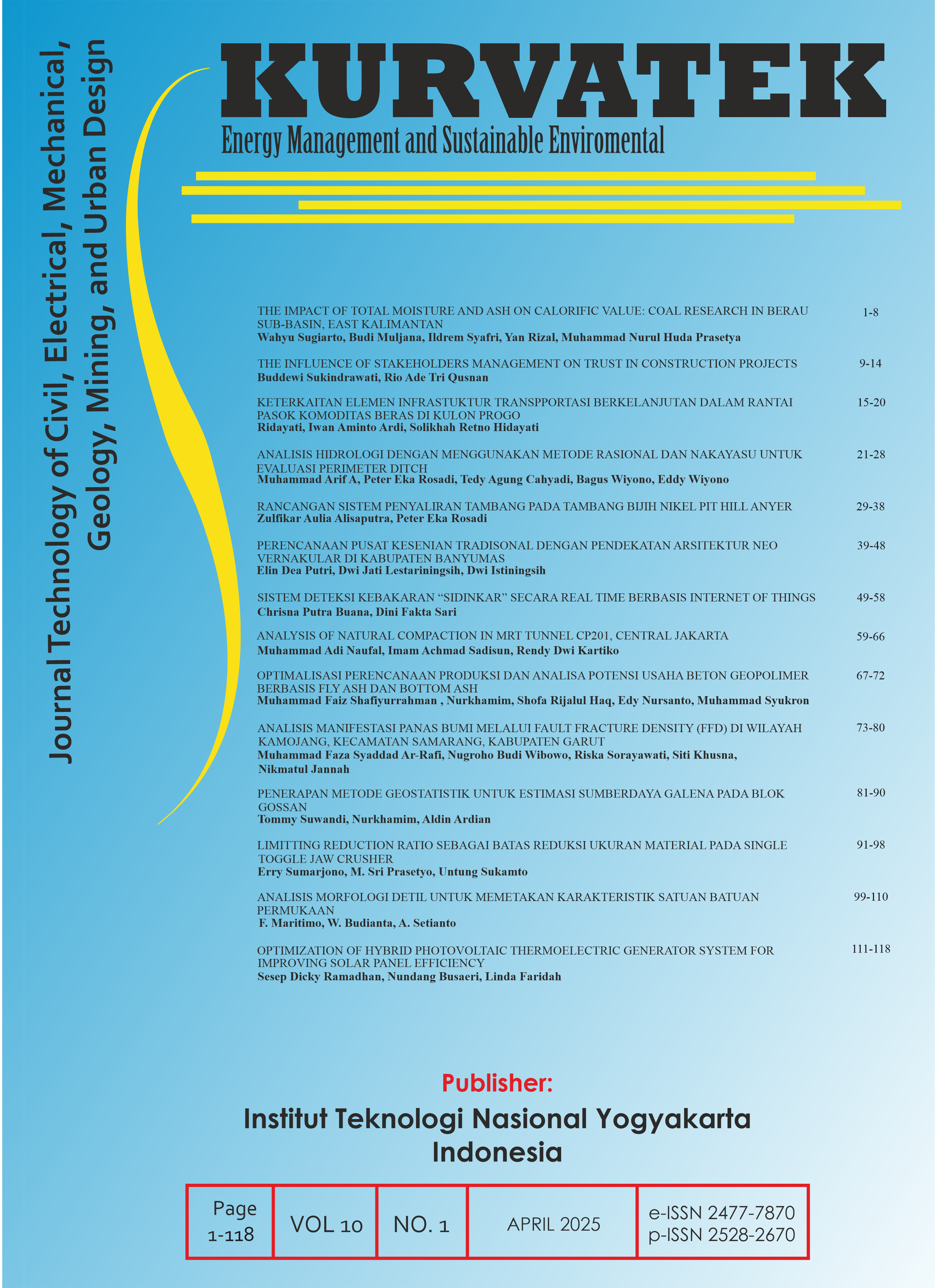RELATIONSHIP OF SUSTAINABLE TRANSPORTATION INFRASTRUCTURE ELEMENTS IN THE RICE COMMODITY SUPPLY CHAIN IN KULON PROGO
DOI:
https://doi.org/10.33579/krvtk.v10i1.5524Keywords:
sustainable infrastructure, supply chain, rice, food security, Kulon ProgoAbstract
Adequate and sustainable infrastructure serves as a strong foundation for ensuring the efficiency, effectiveness, and sustainability of the rice supply chain. The rice supply chain is a complex system involving various actors and processes, from farmers to consumers. In-depth studies of this supply chain are crucial given the importance of rice as a staple food. This article aims to provide an overview of the interconnections between infrastructure elements in the rice supply chain. Previous studies on the rice supply chain have been limited to a single perspective, such as from the perspective of farmers as producers or rice as a product. This article attempts to explore new insights by measuring the interconnectedness of key elements in the rice supply chain. The method used is Network Enabling Transport Service (NETS), which is commonly used in the transportation field. Variables studied include infrastructure, traffic, regulations, communication, support services, and skills. The research results show that the weakest link in the rice supply chain network lies in the regulatory variable. Weak regulations can hinder efficiency, fairness, and sustainability in the supply chain. These findings underscore the importance of improving policies and regulations to support better integration of the rice supply chain. Regulations are particularly related to the development of infrastructure for the efficiency and resilience of the rice supply chain in the face of climate change challenges and demand fluctuations. Adequate infrastructure, such as roads, irrigation, and storage, is crucial to ensure the stable availability of quality rice
Downloads
References
L. R. E. Malau, K. R. Rambe, N. A. Ulya, dan A. G. Purba, “Dampak Perubahan Iklim Terhadap Produksi Tanaman Pangan di Indonesia”, Jurnal Penelitian Pertanian Terapan, vol. 23, no. 1, pp. 34–46, 2023. doi: http://dx.doi.org/10.25181/jppt.v23i1.2418
W. H. La. Tiwu, J. L. Sepang, and P. Van Rate, “Analisis Saluran Distribusi Rantai Pasokan Beras di Bolaang Mongondow (Studi Kasus di Desa Mopugad Utara Kecamatan Dumoga Utara)”, Jurnal EMBA : Jurnal Riset Ekonomi, Manajemen, Bisnis dan Akuntansi, vol. 7, no. 1, pp. 1031-40, 2019. doi: https://doi.org/10.35794/emba.v7i1.23221
S. Pratastik, S. Maulida, S. Kumajas, dan Q. C. Kainde, “Analisis Rantai Pasok Beras di Tebing Tinggi”, EduTIK: Jurnal Pendidikan Teknologi Informasidan Komunikasi, vol. 1, no. 5, pp. 450-468, 2021. doi: https://doi.org/10.53682/edutik.v1i5.2759
BPS Kabupaten Kulon Progo, Kabupaten Kulon Progo dalam Angka Tahun 2022, 2022.
BPS Kabupaten Kulon Progo, Kabupaten Kulon Progo dalam Angka Tahun 2024, 2024.
L. F. Costa, F. A. Rodrigues, G. Travieso, and P. R. V. Boas, “Characterization of Complex Networks : A Survey of measurements”, Advances in Physics, vol. 56, pp. 167-242, 2007. doi: 10.1080/00018730601170527
J. Tiffin and C. Kisslilng, Transport Communication: Understanding Global Networks Enabling Transport Serices. London: Cogan Page, 2007.
G. Qi, W. Shi, K. C. Lin, K. F. Yuen, and Y. Xiao, “Spatial Spillover Effects of Logistics Infrastructure on Regional Development: Evidence from China”, Transportation Research Part A: Policy and Practice, vol. 135, pp. 96–114, 2020. doi: https://doi.org/10.1016/j.tra.2020.02.022
H. A. Priyajati dan T. Haryanto, “Hubungan Logistik Terhadap Pertumbuhan Ekonomi: Studi Kasus 9 Negara Emerging Markets Asia”, Media Trend., vol. 15, no. 1, pp. 133–46, 2020. doi: https://doi.org/10.21107/mediatrend.v15i1.6637
W. Kartikasari, D. Setiawan, dan E. Fauziah, “Efektifitas Transportasi dan Lokasi Terhadap Distribusi Logistik di Wilayah Komando Armada I TNI-AL”, Rekayasa, vol. 14, no. 2, pp. 183–90, 2021. doi: https://doi.org/10.21107/rekayasa.v14i2.10968
Y. A. Widiyanto, B. Triatmodjo, dan D. Parikesit, “Evaluasi Fasilitas Eksisting Pelabuhan dan Rencana Pengembangan Pelabuhan Sunda Kelapa”, Prosiding Seminar Nasional Pascasarjana Departemen Teknik Sipil FT-UI. Depok, pp. 82–92, 2019.
Downloads
Published
How to Cite
Issue
Section
License
Copyright (c) 2025 Ridayati Ridayati, Iwan Aminto Ardi, Solikhah Retno Hidayati

This work is licensed under a Creative Commons Attribution-ShareAlike 4.0 International License.
This journal provides immediate open access to its content on the principle that making research freely available to the public supports a greater global exchange of knowledge.
All articles published Open Access will be immediately and permanently free for everyone to read and download. We are continuously working with our author communities to select the best choice of license options, currently being defined for this journal as follows:
• Creative Commons Attribution-ShareAlike (CC BY-SA)

This work is licensed under a Creative Commons Attribution-ShareAlike 4.0 International License.










